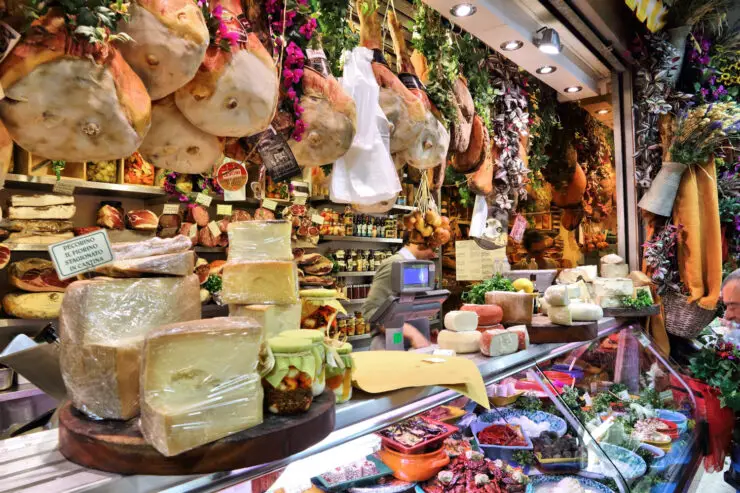As an Amazon Associate I earn from qualifying purchases. Please read the disclaimer for more info.
Tuscan cuisine is as much about simplicity as it is about flavor. From hearty soups like ribollita to rustic bread like pane toscano, traditional Tuscan food embodies rustic elegance. Olive oil, beans, and premium meats like the famed Chianina beef provide a steady foundation for dishes that need no complicated seasonings to shine.
The simplicity of Tuscan recipes often surprises those used to the more intricate Italian dishes found in other regions.
As you explore the Tuscan food guide, you’ll notice the emphasis on locally sourced ingredients that follow the seasons. Tuscany is a feast for the eyes with its rolling hills, charming vineyards, and a paradise for your palate.
There’s a strong tradition of farm-to-table dining long before it became trendy elsewhere. The region’s staple of legumes, particularly the cannellini bean, figures in many dishes and speaks to the soul of Tuscan cooking—honest, unpretentious, and deeply satisfying.
And let’s not forget the wines; after all, you’re in the birthplace of Chianti. Each meal is an opportunity to savor the harmony between food and wine, a balance that Tuscans have perfected over centuries.
Dining in Tuscany is as much about tradition as it is about taste. The region’s history is told through age-old culinary customs passed down through generations. When you bite into a slice of lardo di Colonnata or savor the simplicity of a perfectly grilled bistecca alla Fiorentina, you’re experiencing a piece of Tuscan heritage.
There’s no rush in a Tuscan meal; it’s a time to relax, enjoy your company, and let the flavors transport you to the heart of Italy.
Culinary Experiences for Foodies: 7 Best Tuscany Cooking Vacations 2024: A Taste of Tuscany
History of Tuscan Cuisine
Tuscan cuisine, rooted in antiquity, has been shaped by historical events and influential patrons. You’ll see how the Medici family’s tastes elevated the region’s food and how the humble beginnings of cucina povera evolved into today’s cherished dishes.
Influence of the Medici Family
The Medici family’s rule from the 15th to the 18th century brought an era of opulence to Tuscany. They employed chefs who introduced new ingredients and techniques, setting the standard for fine dining in the region.
Among these ingredients were citrus fruits, particularly oranges, and lemons, which became a staple in many Tuscan dishes owing to their fresh and vibrant flavors.
In addition to these, the Medici also introduced exotic spices into the culinary scene. Saffron was brought into the limelight with its unique aroma, distinctive golden hue, and nutmeg, known for its warm and slightly sweet taste.
These ingredients not only added depth and complexity to the dishes but also reflected the wealth and cosmopolitan nature of the Medici family.
Evolution From Cucina Povera
Cucina Povera, meaning “poor kitchen,” refers to the simple yet flavorful dishes that originated out of necessity. Rural Tuscan families often had limited resources, making do with what they could grow or forage. These dishes are your most direct link to the region’s agricultural history.
The beauty of these recipes lies in their transformation from survival food to sought-after classics that delight food enthusiasts worldwide.
Tuscan Food Ingredients
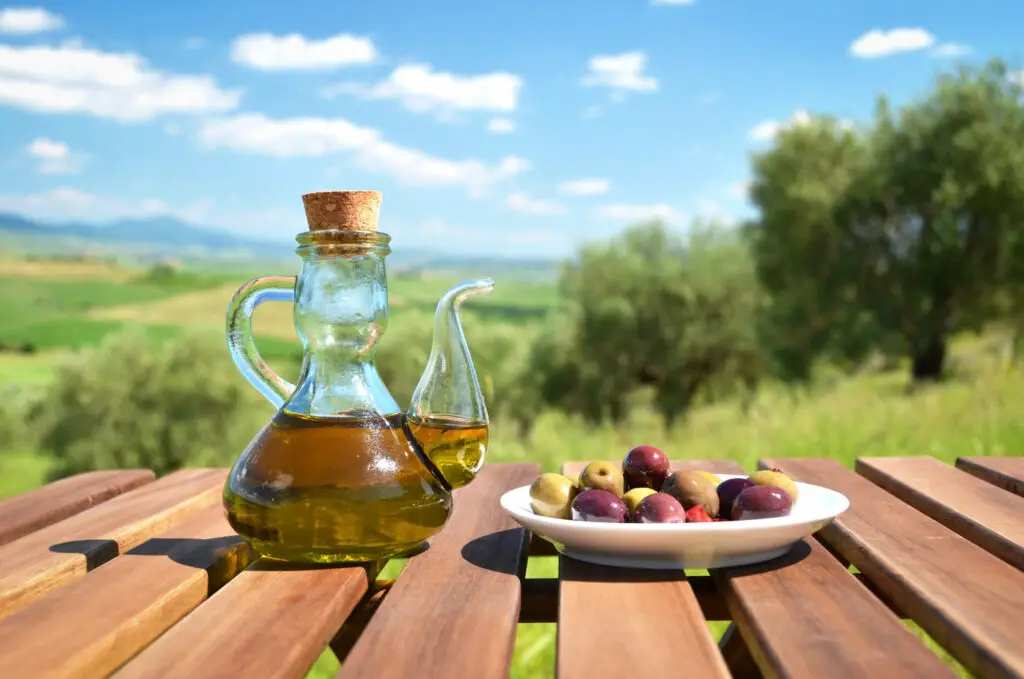
Tuscan food thrives on simplicity and the quality of the ingredients. You’ll discover that olive oil adds a golden touch to most dishes, and local herbs like basil and rosemary infuse them with flavor.
Olive Oil and Herbs
Olive Oil: Central to Tuscan cooking, Tuscan olive oil is robust and full-flavored. Drizzling it onto salads or using it as a dip for your bread, you’ll taste the difference compared to regular olive oils.
Herbs: Fresh herbs, notably basil, rosemary, and fennel, play crucial roles in Tuscan recipes. They add a spectrum of flavors, from sweet to pungent.
Local Meats and Legumes
In Tuscan dishes, meats range from game to pork, known for their rich taste and high quality. Meats often come seasoned with salt, pepper, and local herbs for an enhanced flavor profile.
Legumes, especially beans, are a staple. Hearty and nutritious, they often appear in soups like the wholesome ribollita.
Bread and Pastas
Tuscan Bread stands out as it’s traditionally made without salt, which allows the flavors of the toppings or accompaniments to shine through. It’s perfect for soaking up the region’s hearty sauces.
Pasta is simpler in Tuscany but no less delicious. Found in both dried and fresh forms, it serves as the foundation for many regional dishes, melding beautifully with rich tomato sauces and fresh vegetables.
Cheese and Other Dairy
Pecorino Cheese is the star in the dairy section. Made from sheep’s milk, this cheese ranges from soft and young to hard and aged, making it versatile for cooking and as a table cheese.
Dairy in Tuscany is used relatively subtly to complement the flavors of the primary ingredients, enhancing dishes without overwhelming them.
Culinary Experiences: 10 Best Italian Cooking Vacations 2024: Buon Appetito
Iconic Tuscan Dishes
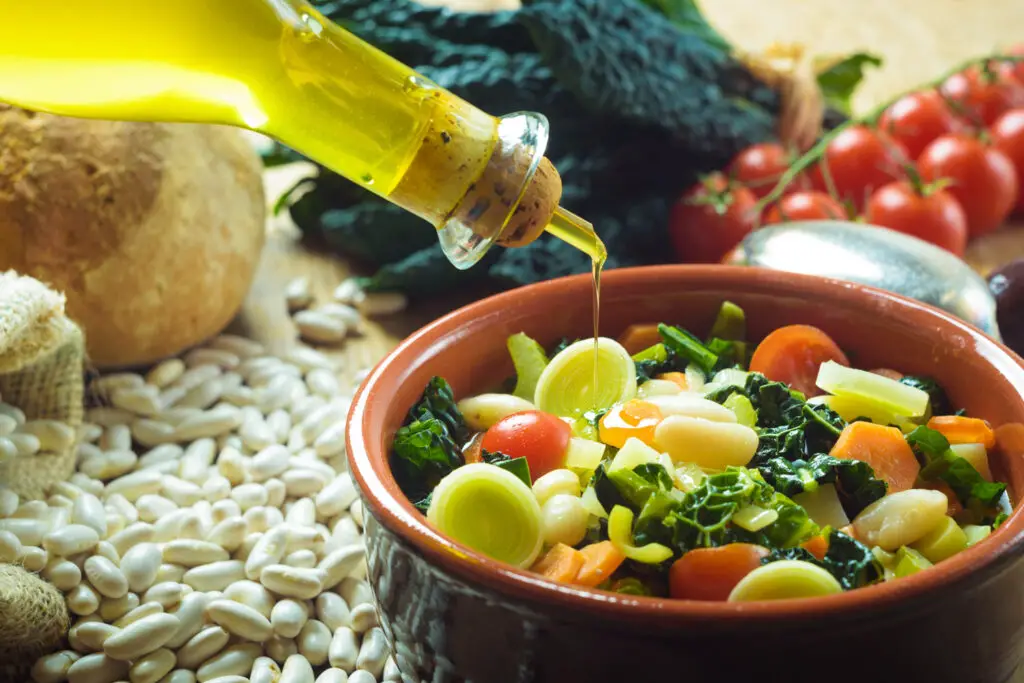
Tuscan cuisine is a rustic feast for the senses, with dishes that are deeply rooted in tradition. You’ll find hearty, simple ingredients turned into something exceptional.
Appetizers and Light Bites
Crostini Neri is your go-to starter. Picture crunchy slices of bread topped with a savory chicken liver pâté. Get your hands on some Panzanella in the summertime; this bread salad is a refreshing mix of tomatoes, basil, onion, and chunks of soaked bread. Though it shouldn’t be mistaken for a light dish—this is comfort food at its finest.
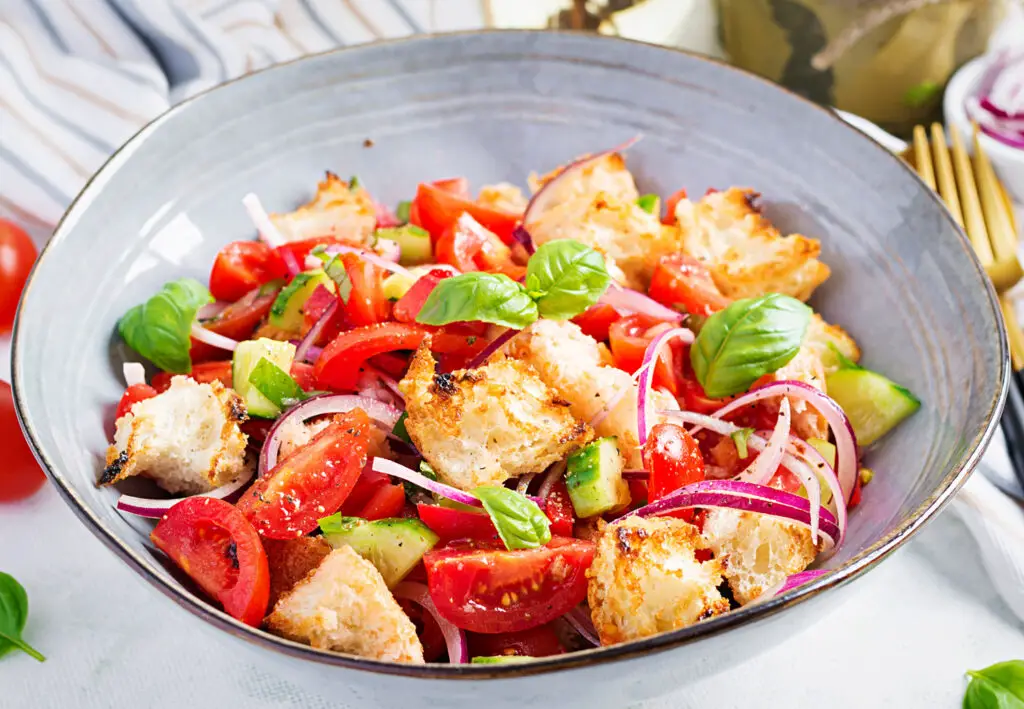
Soups and Stews
When you’re in the mood for something warming, the bread-thickened Ribollita is your go-to soup. It’s a second-day soup, meaning it’s even better the day after it’s made. Tomato lovers dive into a bowl of Pappa al Pomodoro, a dish where ripe tomatoes meld with bread for a flavor-packed experience.
Main Courses
For an authentic taste of Tuscan food, Bistecca alla Fiorentina is a must-try. This thick-cut, chargrilled T-bone steak is seasoned with nothing more than a touch of local olive oil, rosemary, and salt to bring out the flavors of the meat. If you prefer game, Pappardelle al Cinghiale brings wild boar into the mix, served with broad, flat pasta for a hearty main dish.
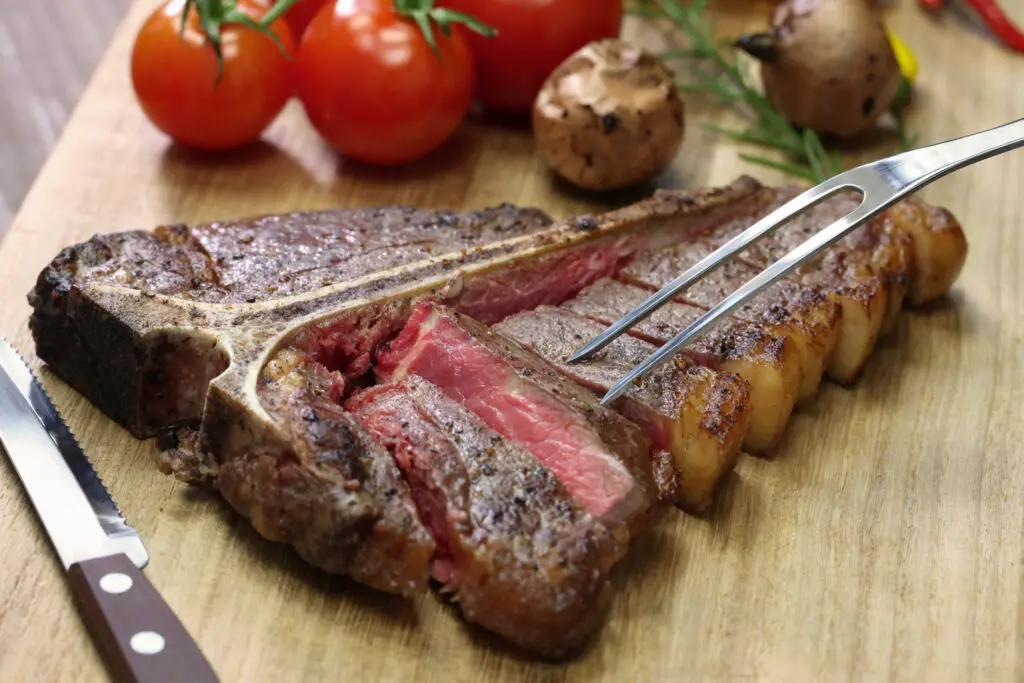
Desserts and Wine Pairings
End your meal on a sweet note with Cantucci, almond biscuits perfect for dunking in Vin Santo, Tuscany’s beloved dessert wine. Or, if you’re up for something unique, try Castagnaccio, a dense chestnut flour cake flavored with rosemary, raisins, and pine nuts. Pair it with a glass of Vin Santo for a quintessentially Tuscan indulgence.
Related: 19 Italian Cheese Types: A Quick Guide To The Best Types
The Role of Tuscan Food in Holidays and Festivals
During holidays and festivals, Tuscan food really shines. You can’t talk about Easter in Tuscany without mentioning lamb, as it symbolizes spring and is a centerpiece in holiday feasting.
Vegan adaptations of Tuscan recipes are more common today as well and are particularly prominent during the Feast of the Seven Fishes, where plant-based versions of seafood dishes are now seen.
Festivals such as the Mushroom Festival in Mugello celebrate the region’s love for its natural bounty, where you can taste a wide variety of delicacies made from freshly picked mushrooms.
Wine and Agriculture in Tuscany
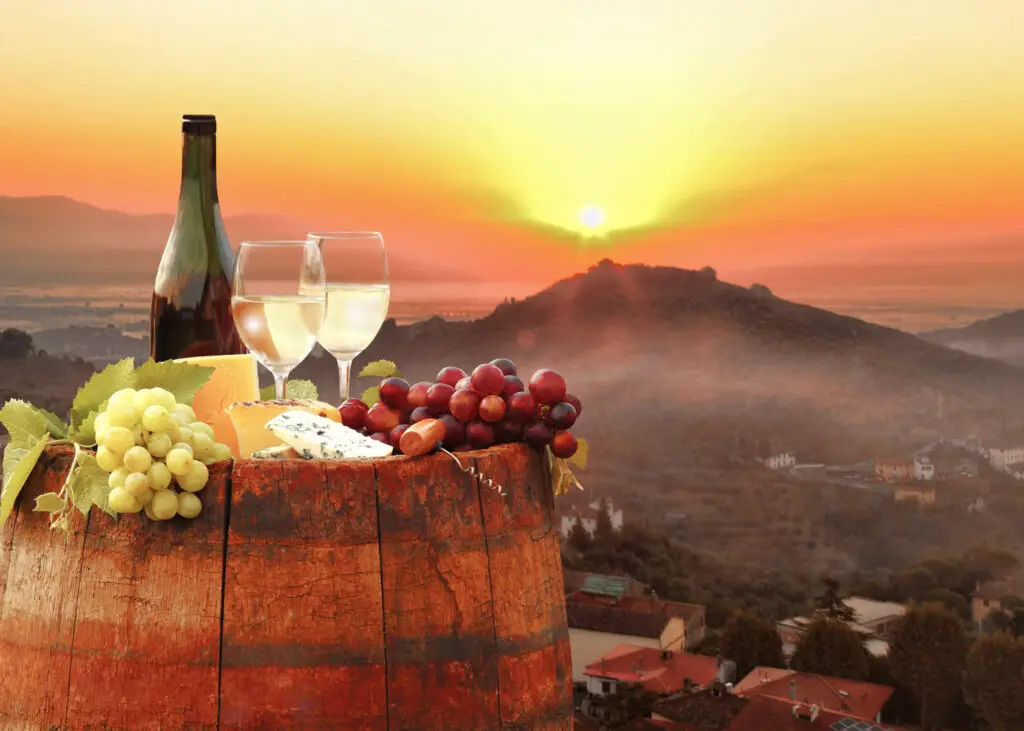
Tuscany’s rolling hills and fertile lands are not just Tuscan countryside eye candy – they’re the birthplace of world-class wines you’ll surely adore. Let’s get to the heart of Tuscany’s wine regions and what makes them unique.
The Chianti Region
In the heart of Tuscany is the Chianti region, a name that resonates with wine lovers worldwide. Here’s what you need to know:
- Wines: Predominantly, Chianti wines are robust reds, with Chianti Classico being the most prestigious. It’s required to have at least 80% Sangiovese grapes.
- Geography: Stretching between Florence and Siena, Chianti’s landscape is varied and rich in both clay and limestone.
- Water: The region is well-irrigated, with abundant water sources that help maintain the vineyards, especially during Tuscany’s dry summers.
Chianti Classico is highly acclaimed for its superior quality and represents the heart of the Chianti region in Tuscany. The exceptional character of this wine can be attributed to the unique soil composition of the vineyards where the grapes are grown.
This soil is a blend of Galestro, a type of schist, and Alberese, a limestone-rich clay, imparting distinct flavors to the wine.
Alongside Chianti Classico, another notable Tuscan product is Vin Santo, a sweet dessert wine.
Although produced in smaller quantities compared to other wines, Vin Santo has managed to garner a loyal following due to its exquisite taste and unique production process.
Brunello and Other Reds
Moving south of Chianti, you’ll encounter other heavyweight Tuscan reds that deserve your attention:
Montepulciano: This is both a place and a wine. Vino Nobile di Montepulciano is definitely noble as the name suggests, not to be confused with Montepulciano d’Abruzzo.
Brunello di Montalcino, a distinguished wine from Tuscany, is made entirely from Sangiovese grapes. Its robust structure makes it ideal for long-term aging, allowing the wine to develop an intricate blend of flavors and an elegant profile over time.
Not far from the vineyards of Montalcino lies the town of Pienza, renowned for its pecorino Toscano cheese.
However, Pienza also contributes to Tuscany’s rich wine landscape with its own vineyards. The aging process of Brunello, which can mature for decades, further enhances its complexity and elegance, making it one of the most sought-after wines in the region.
Regional Variations and City Specialties
Tuscan cuisine reflects the diverse landscape, from the rolling hills of the countryside to its lively coastal areas. With each city comes a distinct culinary twist, embracing local ingredients and traditions.
Dishes from Florence to Siena
In Florence, you can’t miss the chance to try Bistecca alla Fiorentina, a thick-cut T-bone steak usually sourced from the local Chianina cattle and grilled over a wood or charcoal fire. Moving towards Siena, you’ll find Pici, thick, hand-rolled pasta, often served with wild boar ragù, making the most of the game-heavy surroundings typical of the region. Ribollita is a hearty stew whose name means “reboiled,” it is a Florentine comfort food made with bread, cannellini beans, and vegetables, perfect for chilly evenings.
Coastal Influences in Livorno
Livorno, by the sea, offers fresh seafood with a Tuscan twist. Expect dishes like Cacciucco, a spicy fish stew boasting an array of seafood and seasoned with local herbs served with toasted bread rubbed with garlic.
Fresh fish is often prepared alla Livornese, with tomatoes, garlic, parsley, and olive oil, bringing out the flavors of the Mediterranean.
Mountain Delicacies in Garfagnana
Garfagnana, nestled in the Apennine Mountains, is renowned for rustic and earthy dishes. Here, you can enjoy plates made with chestnut flour, like the region’s beloved Castagnaccio, a dense, nutty cake enriched with rosemary, pine nuts, and raisins native to the area.
This mountainous region thrives on its use of local produce, including mushrooms and potatoes that find their way into stews and hearty mountain meals.
Take note of the Mugello region as well, just north of Florence, known for its Tortelli di Patate, ravioli stuffed with a rich potato filling that encapsulates the essence of Tuscans’ love for simple, high-quality ingredients.
If a visit to Montalcino is in your plans, don’t miss the chance to sample the local artisan cheeses, perfect accompaniments for the world-renowned Brunello di Montalcino wine.
Common Cooking Techniques and Traditions
In Tuscan cuisine, making the most of every ingredient is essential. From turning stale bread into culinary delights to meticulously preparing meats, these methods create delicious food and reflect a history of frugality and sustainability.
Utilizing Stale Bread and Leftovers
Stale bread is never wasted in your Tuscan kitchen. It transforms into Panzanella, a refreshing salad where bread is soaked and mixed with tomatoes and onions, or serves as the foundation for Ribollita. This hearty soup combines leftover bread with cannellini beans and vegetables.
Meat Preparation and Preservation
Your Tuscan meat dishes often feature local specialties such as Chianina beef, renowned for its rich flavor and used in the iconic Bistecca alla Fiorentina—a thick-cut T-bone steak grilled over a wood fire to achieve a smoky char. When it comes to preservation, salting, and air-drying meats are common, be it finely sliced prosciutto or rich, flavorful lardo.
- Curing: Salt cures meats, drawing moisture to preserve and concentrate flavors.
- Grilling: Wood fire grills impart a distinct smokiness, perfect for Chianina T-bone steaks.
The Art of Pasta Making
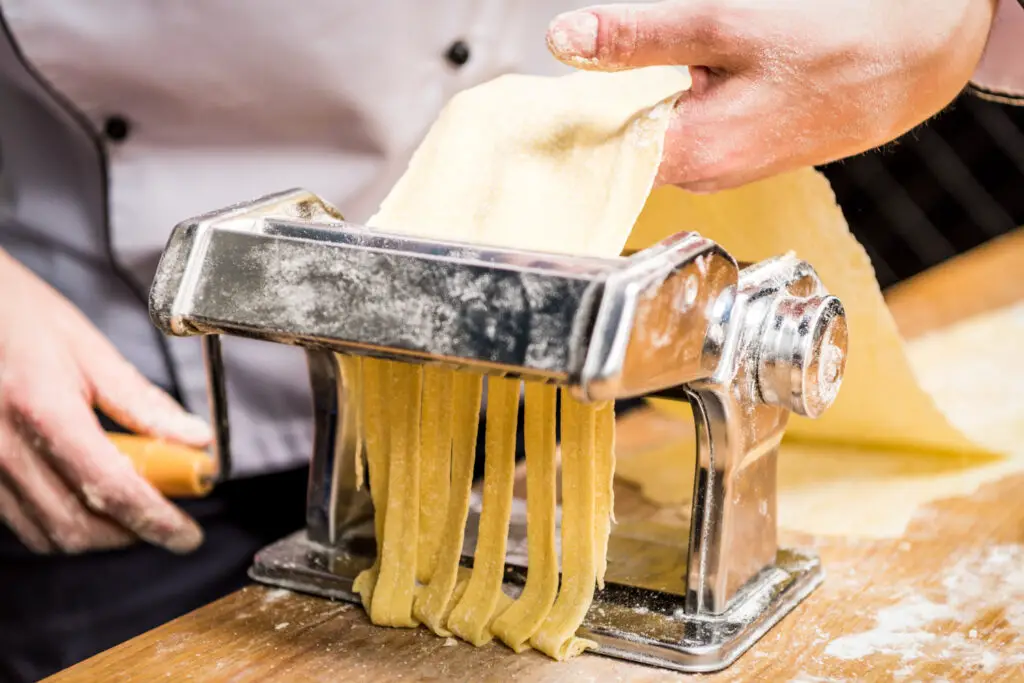
Fresh pasta is a labor of love and a testament to the simplicity of Tuscan cooking. You’ll combine flour and eggs into a dough, then knead and shape by hand to create varieties like Pappardelle, ideal for clinging to rich, gamey sauces. A well-made pasta is a vehicle for other flavors, such as a robust tomato sauce simmered with garlic and basil.
Kneading is a crucial skill in bread and pasta making, where a firm, rhythmic motion is required to develop the gluten in the dough. This process imparts elasticity to the dough, which is essential for its texture and structure.
On the other hand, the art of rolling dough is all about precision and control. In a cooking class, you will learn that the thickness of the dough plays a significant role in the final product.
For instance, pasta such as ravioli and potato tortelli require a thin dough, while a thicker one is ideal for pappardelle.
These techniques can seem daunting at first, but under the guidance of a skilled instructor, you can learn to master them, enhancing your culinary skills and confidence in the kitchen.
Eating Out in Tuscany
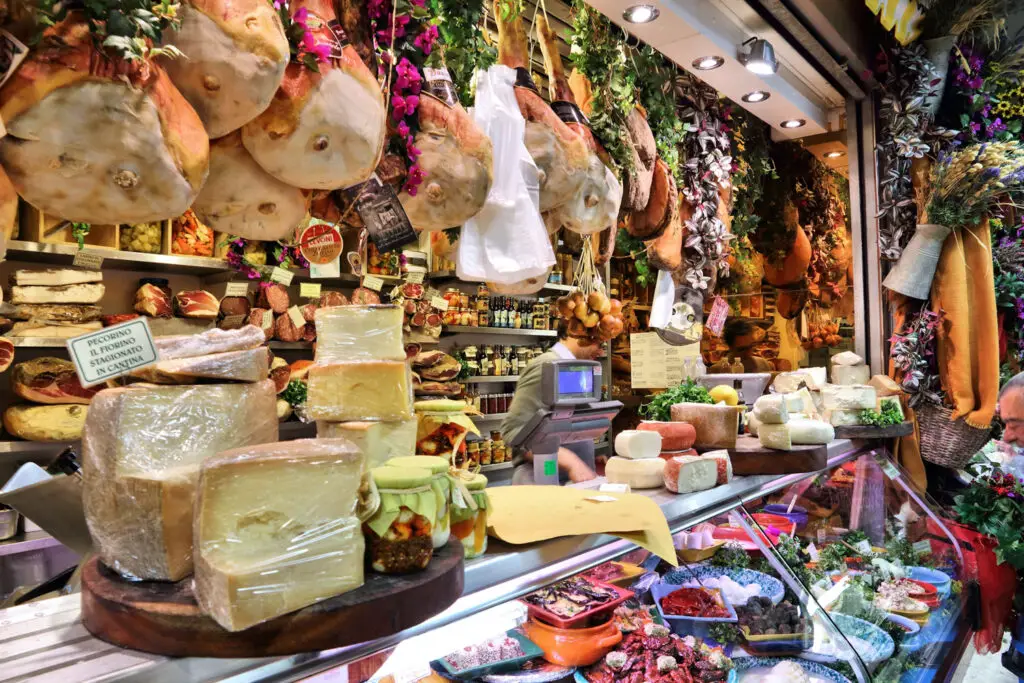
Exploring Tuscany’s culinary scene is a journey filled with fresh, hearty flavors and traditional dishes that have been perfected over generations. From bustling local markets to the warm, inviting ambiance of family-run trattorias, prepare to indulge in a true taste of Tuscany.
Local Markets and Street Food
When you amble through Tuscan markets, you’re not just shopping but immersing yourself in a vibrant food culture. It’s where you grab a bite of the local street food while you shop. Be sure to sample the lampredotto, which is tender and flavorful; it is a type of tripe sandwich served with a piquant salsa verde made from capers, parsley, garlic, and black pepper.
- Must-Try Market Finds:
- Lampredotto Sandwich
- Potato Crostini
- Fresh Spinach and Cabbage
Markets not only showcase a variety of fresh vegetables like onions, garlic, celery, cabbage, and spinach, but you might also stumble upon stalls selling thick slices of stale bread, perfect for making ribollita—a hearty vegetable soup enriched with bread and Tuscan olive oil.
Guide to Tuscan Restaurants and Trattorias
Conversations in Tuscan restaurants and trattorias are lively, and every dish’s connection to tradition is evident. Start with a plate of crostini toscani, where toasted bread meets a robust topping, often a mash of chicken liver, capers, and anchovies, or rubbed with garlic and covered with fresh tomato.
Whether you select a pappa al Pomodoro, a warm tomato soup thickened with stale bread and generously seasoned with garlic and basil, or a bowl of ribollita, each spoonful tells a story of Tuscan culinary history.
Expect plenty of freshly ground black pepper and a drizzle of locally produced extra virgin olive oil as the finishing touch on many dishes.
If you found this article useful, you might enjoy one of these:

